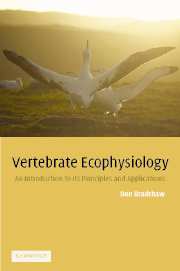Book contents
- Frontmatter
- Contents
- Introduction
- 1 Homeostasis: a fundamental organising paradigm in ecophysiology
- 2 Stress: the concept and the reality
- 3 Basic methods used in ecophysiological studies
- 4 Turnover methodology: theory and practice
- 5 Case studies of stress: incidence and intensity
- 6 Survival in deserts
- 7 Torpor and hibernation in cold climates
- 8 Marine birds and mammals
- 9 Conclusion
- Appendix 1 Population estimation methods
- Appendix 2 Estimation of food intake in Tiliqua rugosa
- Appendix 3 Simultaneous measurement of sodium and potassium concentration in plasma or urine using the IL 143 digital flame photometer
- Appendix 4 Determination of plasma urea nitrogen
- Appendix 5 Radioimmunoassay of testosterone in plasma
- Appendix 6 Preparation of ‘stripped plasma’
- Appendix 7 Radioimmunoassay of testosterone in faeces
- Appendix 8 The comparative method
- Appendix 9 Basic turnover equations
- References
- Index
Appendix 4 - Determination of plasma urea nitrogen
Published online by Cambridge University Press: 05 June 2012
- Frontmatter
- Contents
- Introduction
- 1 Homeostasis: a fundamental organising paradigm in ecophysiology
- 2 Stress: the concept and the reality
- 3 Basic methods used in ecophysiological studies
- 4 Turnover methodology: theory and practice
- 5 Case studies of stress: incidence and intensity
- 6 Survival in deserts
- 7 Torpor and hibernation in cold climates
- 8 Marine birds and mammals
- 9 Conclusion
- Appendix 1 Population estimation methods
- Appendix 2 Estimation of food intake in Tiliqua rugosa
- Appendix 3 Simultaneous measurement of sodium and potassium concentration in plasma or urine using the IL 143 digital flame photometer
- Appendix 4 Determination of plasma urea nitrogen
- Appendix 5 Radioimmunoassay of testosterone in plasma
- Appendix 6 Preparation of ‘stripped plasma’
- Appendix 7 Radioimmunoassay of testosterone in faeces
- Appendix 8 The comparative method
- Appendix 9 Basic turnover equations
- References
- Index
Summary
Urea nitrogen
Urea is synthesised in the liver from ammonia produced as a result of deamination of amino acids and is the chief means of excreting nitrogen from the animal. It is customary in most laboratories to express urea as urea nitrogen. This came about from the desire to compare the quantity of nitrogen excreted in the form of urea with other nitrogenous compounds. Hence, the standardisation of the method is in units of urea nitrogen. Since the molecular mass of urea is 60 Da and it contains two nitrogen atoms, with a combined mass of 28 Da, an urea nitrogen value can be converted to urea by multiplying by 60/28 or 2.14.
Method principle
Urea is hydrolysed to ammonium carbonate by urease, and the ammonia that is released from the carbonate by alkali reacts with phenol and sodium hypochlorite in an alkaline medium to form a blue indophenol. Sodium nitroprusside serves as a catalyst. The intensity of the blue colour is proportional to the quantity of urea in the specimen.
Reagents
Phenol nitroprusside solution
Dissolve 5 g phenol and 25 mg sodium nitroprusside in 500 ml double-distilled (d-d) water. Store at 4 °C. Stable for two months.
Alkaline hypochlorite
Dissolve 2.5 g NaOH in 250 ml d-d water in 500 ml volumetric flask. Cool, add 0.21 g sodium hypochlorite. Mix well and make up to 500 ml with d-d water. Store in an amber bottle at 4 °C. Stable for 2 months.
- Type
- Chapter
- Information
- Vertebrate EcophysiologyAn Introduction to its Principles and Applications, pp. 210 - 211Publisher: Cambridge University PressPrint publication year: 2003



